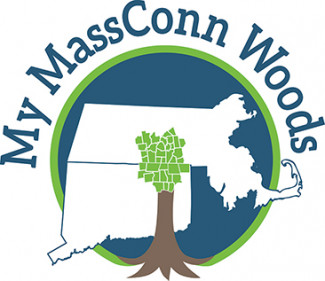by Morgan Smith, American Forest Foundation, and Lisa Hayden, New England Forestry Foundation
Your woods offer a variety of benefits including recreation, wildlife, family legacy, scenery, income, and more. Regardless of what value your woods provide, you likely love your woods and want to keep them healthy into the future.
Wondering where to start planning for the future? This exciting activity requires you to think not only about your overall goals for your land, but about the impact a changing climate may have on your woods. Although considering climate change may seem overwhelming and uncertain at first, it doesn’t have to be. There are many activities that you can do on your land to increase the resiliency of your woods as conditions change.
The My MassConn Woods program—a partnership between the American Forest Foundation, the New England Forestry Foundation, the MassConn Sustainable Forest Partnership, and the Northern Institute of Applied Climate Science—is focused on empowering woodland owners in Massachusetts and Connecticut to increase the resilience of their woodlands in changing conditions with the help of a professional forester.
The MassConn landscape, like many others, has already started to see the effects of climate change. Increases in precipitation, rising temperatures, and an expanded presence of forest pests and diseases have all been observed regionally. Woodland owners across the landscape are now implementing activities on their land that will increase the resilience of their woods to prepare for changing conditions.
For example, Bet Zimmerman Smith, who with her husband Patrick, owns 30 acres in Woodstock, CT, received a visit from licensed consulting forester Eric Hansen as part of the program.
“We felt very fortunate to get connected to forester Eric Hansen. During a visit to our property, he gave us excellent, practical recommendations on how to sustainably manage our 30-acre wildlife refuge,” said Bet. Eric offered useful tips on how to prepare for the changing climate, and how to best attract wildlife. One of our biggest challenges is managing invasive plants, since the property had been untouched for 4 decades, and is loaded with winged euonymus, multiflora rose, Japanese honeysuckle, autumn olive, Asiatic bittersweet, and the dreaded tick-infested Japanese barberry. Unfortunately Eric also identified some new invasives we hadn’t: Japanese stiltgrass and glossy buckthorn. We learned a lot from Eric, and ended up hiring him to prepare a complete Forest Management Plan.”
Some specific actions that may increase the resilience of your woods are:
- Protect water and soils on your land from extreme precipitation events
- Improve ability of your trees to resist bugs and disease
- Prevent and control non-native plants and weeds that threaten native plants and animals
- Protect young trees from excessive deer browsing
- Prepare for big weather events by promoting strong, healthy trees in your woodlot
- Respond quickly after big disturbance events to help your woods bounce back
- Promote a diversity of tree species
- Promote a diversity of tree sizes
- Protect rare or sensitive plant and animal communities
- Consider how your current trees will react to future conditions and which tree species you might want to promote.
To learn more about why these activities are important, take a look at the My MassConn Woods fact sheet. Even though you may live in a different region or have a very different woods from these woodland owners, you can still follow a similar approach as you think about how to keep your woods healthy through the years ahead.
The best place to start is by talking with a natural resources professional such as a forester. A professional can walk your woods with you and give you recommendations that are specific to you and your land. A consulting forester can also prepare a comprehensive forest management plan that details recommendations into the future.
Don’t know where to find a forester? My Land Plan is another great resource for woodland owners where you can learn how to find the right forester for you and look up foresters in your area. Preparing your woods for changing conditions doesn’t have to be overwhelming, especially with the help of a professional.


